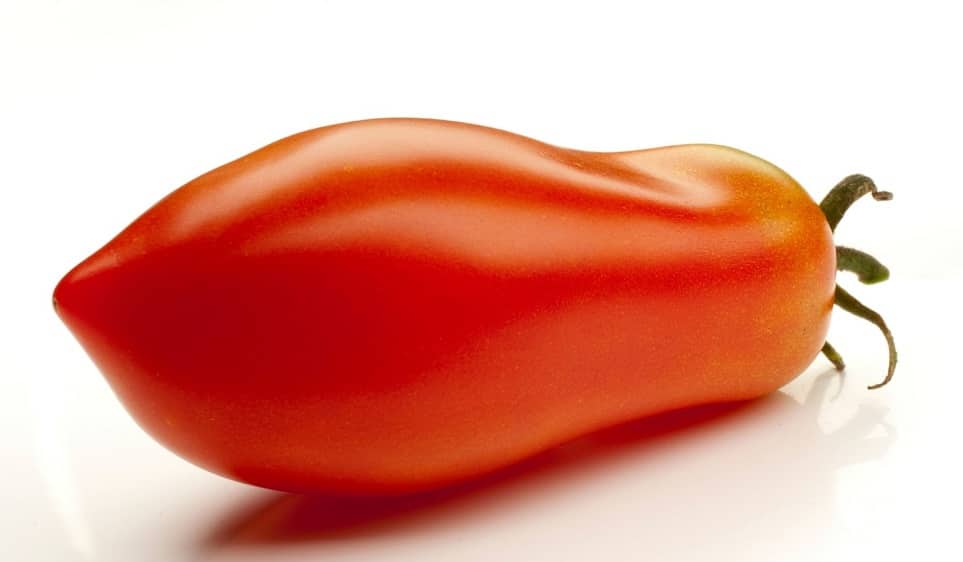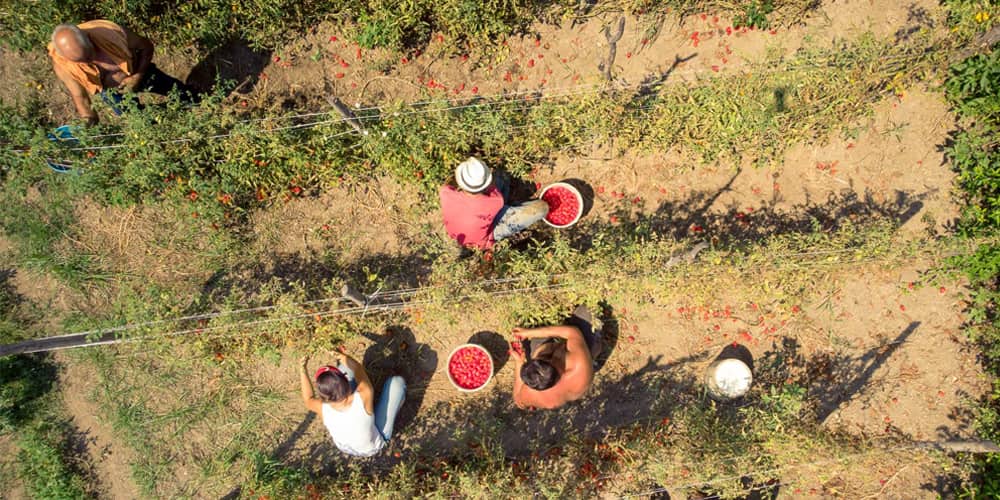The Campanian tomato represents Italian excellence, a symbol of Mediterranean culinary culture, and a staple in many traditional recipes. From the fertile lands of Campania, where an ideal climate and volcanic soil richness converge, renowned varieties such as the San Marzano tomato, the Vesuvian Piennolo cherry tomato, and the Quisisana cherry tomato flourish, each offering unique characteristics in flavour, texture, and versatility.
Campanian tomatoes enhance iconic dishes like pasta and pizza and carry a history rooted in centuries-old traditions and knowledge passed down through generations. Their intense flavour, often associated with the authenticity of the Mediterranean diet, results from a strong bond between the land and traditional cultivation techniques. This article will explore how the Campanian tomato has become a true gastronomic icon, tracing its origin, evolution, and significance in Italian and international cuisine.

The importance of the campanian tomato in Italian tradition

The tomato is one of the key vegetables in traditional Italian cuisine. Tomato-based recipes are countless and have been passed down through generations without interruption. We often hold memories of childhood closely linked to tomatoes, which have always played a starring role on our tables. This is why I aim to share the story of how the most iconic fruit (or vegetable, depending on perspective) in our history was born and evolved over the years, particularly in the Campania region.
In Campania, the tomato found an ideal home, deeply connected to the land and ancient local traditions. It is here that this vegetable flourished, becoming a symbol of regional identity. The unique relationship between the tomato and the Campanian soil has allowed this fruit to evolve and thrive over time, weaving its story with that of the communities who cultivate it and safeguard its value. Its intense flavour, closely linked to the authenticity of the Mediterranean diet, results from a unique combination of soil, climate, and local cultivation techniques.
The origins of tomato

It might seem obvious to think of tomatoes as inherently Italian, but they actually originate from South America and only arrived in Europe around the turn of the 16th century. The first European landing occurred in Spain in 1540, where tomatoes were initially used solely for decoration, not for cooking. European nobles often had themselves portrayed with exotic fruits. This gave rise to the name 'pomo d’oro' ("golden apple") due to its original colour, which resembled that of the precious metal.
Tomatoes made their way to Italy shortly after arriving in Spain, facilitated by relations between Italian duchies and the Bourbon Empire. Unlike in other European countries, Italy’s temperate climate was ideal for this plant, enabling it to quickly become a staple on Italian tables. Most culinary experimentation took place, particularly in southern Italy.
The evolution of the Campanian tomato across the peninsula is interwoven with countless small stories and traditions, giving rise to various famous varieties, from the 'occhio di bue' (oxheart) to the 'ciliegino di Pachino IGP' (protected designation of origin cherry tomato). For this reason, the queen of tomatoes in Italy is undoubtedly Campania, a region that preserves the most delicious recipes and varieties.
Campania and tomatoes: the symbol of this area

Tomatoes are one of the most iconic products deeply rooted in the agricultural tradition of Campania, a region where cultivating diverse varieties has created a true tomato culture. Here, the climate and volcanic soil enrich tomatoes with an intense flavour and unique organoleptic qualities. Among the most renowned varieties is the San Marzano DOP tomato, primarily grown in the Agro Nocerino-Sarnese area, celebrated for its elongated shape and dense pulp, ideal for preserves and sauces. Another prized variety is the Vesuvian *Piennolo* cherry tomato, known for its sweet, slightly tangy flavour; it is preserved in hanging clusters and left to ripen slowly—a traditional technique that enhances its taste and allows it to be stored for months.
Completing this rich variety is the Sorrento tomato, known for its large size and meaty texture, perfect for fresh salads and the classic 'caprese', as well as the 'pomodorino' from the hills of Quisisana near Stabia, cultivated in mineral-rich soils and appreciated for its natural sweetness and versatility in local dishes. Each type of Campanian tomato reflects not only the region’s biodiversity but also traditional agricultural practices that respect the rhythms of nature. Through generations of farmers' dedication, Campania has transformed the tomato into a symbol of regional identity, combining ancient flavours with modern techniques to celebrate this precious fruit to its fullest.
San Marzano: the most famous tomato from Campania

The San Marzano tomato is known all over the world and is one of the leading exponents of Campania cuisine and the Mediterranean diet. The San Marzano tomato is red with compact and fleshy pulp. It has a shape similar to a cylinder which tends to widen towards the tip.
This tomato is particularly suitable for peeling, perfect for uses in the processing industry. It is fit for any application and is the most used for industrial peeling and countless recipes.
In 1996 it became a DOP product that preserved its existence, put to the test in the 1980s. The cultivation takes place in flat and soft soils, often of volcanic nature and are widespread in the province of Naples, Avellino and in particular in the Salerno countryside from where it originated.
The piennolo of Vesuvius: the real

The Piennolo del Vesuvio Dop tomato is also one of the typical and ancient products of Campania. Its unique feature lies in the method of conservation and its conformation. It is stored with a traditional technique in which the tomatoes are tied in large clusters and hung until spring arrives to ripen. This phase gives the tomato its bright red colour and its deliciously sweet and sour flavour.
The Piennolo tomato is grown on the slopes of Vesuvius or generally on soils of highly volcanic origin such as the area of Somma Vesuviana. An environmental curiosity is that no irrigation water or fertilizers are used for the Piennolo tomato cultivation.
Quisisana tomato: POMODAMA, the real treasure of the Stabia royal palace

It has always been the destination of all the kings of Naples. Charles I of Anjou built it in a place with healthy air and beneficial effects, that have ended up giving the name to the whole area. In this natural stage, the Quisisana tomato, the pomodama, is born, grown in the lands of the homonymous royal palace with the same traditional techniques, handed down from generation to generation. This centennial tradition is represented by the D'Auria family, who has been working in these lands since 1800, offering a product of excellence in Campania. In 2015, the tradition came back into vogue with the foundation of the DAMA farm, which transformed a traditional and familiar product into a real farm, where ancient knowledge and centuries-old methods give uniqueness to the product.
The pomodama has the purest flavours of the past and is divided into two types: the light bulb and the pendulum. The light bulb is one of the oldest species. It has a bright red colour and takes its name from its elongated and slightly enlarged shape in the centre. The pendulum, on the other hand, has a rounded shape with a point at the end. If you want to buy something special, the "pomodama" is a good idea as the other products of the farm.
CATALOGO PRODOTTI POMODAMAThe tomato is widespread throughout the Italian peninsula and is not limited to the famous Campania cases. The goodness of tomato can be found in Salento, Sicily, Piedmont, Tuscany and many other Italian regions, each with its peculiarities and flavours.
Don't wait any longer! Come and try the flavours and goodness of Italian tomatoes.
About the author
Written on 28/04/2021




Mario Galterisi
The tomato is one of the icons of Italian cuisine. It forms the basis of many Italian dishes, from the famous pasta with tomato sauce to the pizza